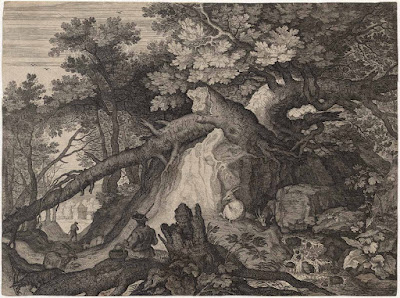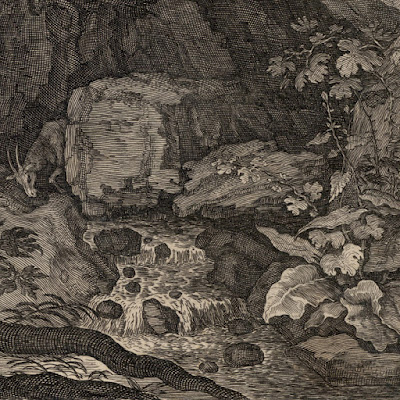Aegidius
Sadeler II (also Egidius or Gilles) (1568–1629)
“Waterfall with
Shepherd and Four Goats”, c.1610–13, from a series of six landscapes after
drawings by Roelant Savery (1576–1639) (note that the Savery’s drawing for this
print is now lost).
Etching and
engraving on fine laid paper trimmed to the image borderline.
Size: (sheet)
21.1 x 28.3 cm
I am unable to
determine the state of this impression (there are six states in total) as the
publication details have been trimmed off. Nevertheless, the impression is
richly inked and crisp showing very little, if any, wear suggesting that this
is an early impression and no doubt a lifetime impression.
Bartsch 72 (1998:
Part 2, Supplement) 7201.39; Nagler 1835–52, no. 228; Le Blanc, no. 204–09 ;
Wurzbach, no. 106; Hollstein 1980, vol. 21, no. 231
(see description of this print that is also
trimmed to the borderline in Museum of San Francisco: http://art.famsf.org/aegidius-sadeler-ii/waterfall-shepherd-and-four-goats-set-six-landscapes-19633014031)
Condition: Crisp
and strong impression of this extremely rare print in superb condition (i.e. there
are no stains, holes, folds or foxing). The print is trimmed to the image borderline
and on the back there are remnants of mounting hinges and a strip of reinforcing
(?) paper at the top centre.
I am selling
this print of the utmost rarity by Aegidius
Sadeler (so rare in fact that even the British Museum does not possess a copy) for
AU$534 in total (currently US$403.31/EUR360.93/GBP308.49 at the time of posting
this listing) including postage and handling to anywhere in the world.
If you are
interested in purchasing this remarkably fresh early impression of an extremely
rare print that is seldom (if ever) seen on the market, please contact me
(oz_jim@printsandprinciples.com) and I will send you a PayPal invoice to make
the payment easy.
This print has been sold
This is a print
of exceptional rarity. It is part of a series of six landscapes of similar size that Aegidius Sadeler II
executed after drawings by Roelant Savery.
From my
standpoint, what makes this image particularly interesting is that it is a fine
example of the notion that was current in the 16th century—and is possibly
still current—of animism (i.e. the attribution of a living soul to plants,
inanimate objects, and natural phenomena). For instance, artists often featured
caves, chasms, natural rock arches and similar formations were the earth exposes
a secondary world below the surface terrain. Going further, artists like Savery
and Sadeler, leaned towards the insignificance of man compared to God’s
handiwork in creating the landscape by ensuring that staffage figures were small in comparison to the surrounding landscape.








No comments:
Post a Comment
Please let me know your thoughts, advice about inaccuracies (including typos) and additional information that you would like to add to any post.